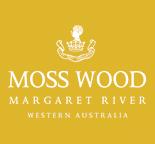 Recently I had the opportunity to taste through the wines of Moss Wood. They’re an Australian producer with a history dating to 1969. Their current winemaker Keith Mugford has been making the wines since 1979. Since 1984 Keith and his wife Clare have run the entire operation at Moss Wood. In their time at the helm they have made thoughtful advances such as being up to 75% in screw cap as far back as 2003. They’re located in Wilyabrup which is a sub-section of the Margret River region.
We started the evening by tasting a trio wines from four varietal verticals. Semillon, Chardonnay, Pinot Noir and Cabernet Sauvignon dating as far back as 1990 were the varietals and each was represented by an example from each of the last 3 decades.
Recently I had the opportunity to taste through the wines of Moss Wood. They’re an Australian producer with a history dating to 1969. Their current winemaker Keith Mugford has been making the wines since 1979. Since 1984 Keith and his wife Clare have run the entire operation at Moss Wood. In their time at the helm they have made thoughtful advances such as being up to 75% in screw cap as far back as 2003. They’re located in Wilyabrup which is a sub-section of the Margret River region.
We started the evening by tasting a trio wines from four varietal verticals. Semillon, Chardonnay, Pinot Noir and Cabernet Sauvignon dating as far back as 1990 were the varietals and each was represented by an example from each of the last 3 decades.
Moss Wood 1993 Semillon – This 20 year old Semillon has an obviously darker hue than the others which is natural for a white of this age. Bits of citrus appear on the nose along with a touch of toffee. Plenty of secondary characteristics emerge on the palate to go along with apple and a boatload of baker’s spice. This wine is still vibrant and alive. It’s a lovely and truly gorgeous example of aged Semillon.
Moss Wood 2003 Semillon – A gentle hint of Petrol emerges on the nose of this decade old Semillon. The palate is filled with a bevy of citrus notes. The finish here is long and fleshy with minerals, spice and pineapple characteristics all in abundance. This wine is delicious and giving but it will continue to evolve positively with more time.
Moss Wood 2013 Semillon – This is the current vintage and it has a suggested retail price of $42. Meyer lemon and lime notes light up the nose of this Semillon. Additional fruits such as white fig are part of the gently layered palate. The finish has good persistence and things end with bits of crispy acidity. Compared to the older vintages this wine is a bit reticent now. Time will open it up and allow it to more fully express its charms.
 Moss Wood 1991 Chardonnay – This 22 year old Chardonnay showcases a cavalcade of pure and expressive fruits. There is depth and complexity here to spare. Apple and pear flavors are joined by bits of hazelnut and toast. A bit of butter crème emerges on the finish which has excellent length and persistence. This is a gorgeous wine that exemplifies how fantastic Chardonnay can be when it’s treated appropriately all the way from vineyard to bottle.
Moss Wood 1991 Chardonnay – This 22 year old Chardonnay showcases a cavalcade of pure and expressive fruits. There is depth and complexity here to spare. Apple and pear flavors are joined by bits of hazelnut and toast. A bit of butter crème emerges on the finish which has excellent length and persistence. This is a gorgeous wine that exemplifies how fantastic Chardonnay can be when it’s treated appropriately all the way from vineyard to bottle.
Moss Wood 2003 Chardonnay – This Chardonnay has the darkest hue of the trio. The nose shows a bit of candied apple. The finish is fairly long with zippy acidity, minerals and a wisp of crème fraiche. Not quite as fresh or vibrant as either the 1991 or the 2011 but no less interesting.
Moss Wood 2011 Chardonnay – The current vintage, it has a suggested retail price of $63. Lemon custard and orchard fruits mark the deep and layered palate of this wine. Spices galore are present from the first whiff of the nose through the last, lingering note on the finish. This wine is loaded with gorgeous layers of fruit. It’s delicious now but will be even lovelier with time in the bottle. This release will likely get to a similar spot down the road that the 1991 is at today.
Moss Wood 1994 Pinot Noir – Plum aromas emerge from the still vibrant nose of this Pinot Noir along with mushroom and lot’s of secondary characteristics. Sour cherry notes dominate the palate and lead to a lengthy spice filled finish that also shows off black tea and hints of earth. This is a balanced and exquisite example of well aged Pinot Noir.
Moss Wood 2001 Pinot Noir – Red fruit, leather and a hint of smoked meat fills the expressive nose of this 12 year old Pinot Noir. Lots of cherry and strawberry star on te palate here along with hints of earth and mushroom. Minerals and sour red fruits emerge on the finish which has good persistence. Medium tannins that show a pleasing amount of grip and firm acidity speak to the wonderful structure this wine has. It’s delicious now, but certainly has quite a few years of aging ahead of it.
Moss Wood 2010 Pinot Noir – This is the current release, it has a suggested retail price of $62. Red and black cherry character dominates the nose of this Pinot. Red fruits interspersed with black, are key components throughout the palate, along with a well rounded complement of spices. All of these elements continue through the finish which has nice length. This Pinot is still young and a bit tight right now. It needs some time and a few years in bottle will serve it well. That said a few hours in the decanter are highly recommended if drinking it in the next couple of years.
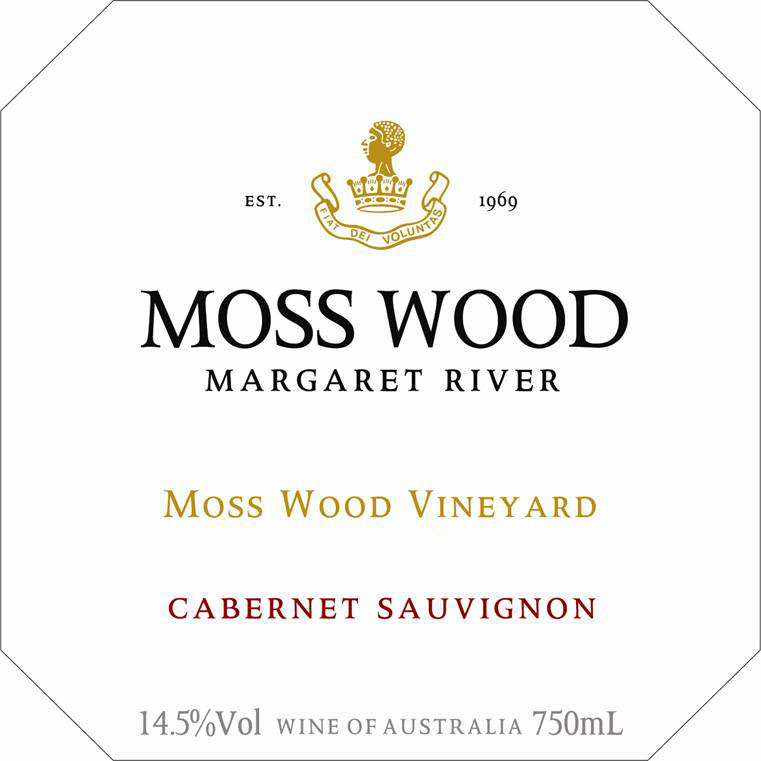 Moss Wood 1990 Cabernet Sauvignon – The fruit on this 23 year old Cabernet has receded and the secondary characteristics have really taken hold. Earth, minerals, espresso and a potpourri of spices are the dominant players here. Chocolate and leather emerge on the finish with some lingering remnants of cherry. If you like your Cabernet Sauvignon aged (and I do), this happens to be an excellent example. It’s beautifully perfumed, loaded with minerals and spice, easy drinking and layered. This is the kind of wine I could hide in the corner with, allowing it to keep me content all night long.
Moss Wood 1990 Cabernet Sauvignon – The fruit on this 23 year old Cabernet has receded and the secondary characteristics have really taken hold. Earth, minerals, espresso and a potpourri of spices are the dominant players here. Chocolate and leather emerge on the finish with some lingering remnants of cherry. If you like your Cabernet Sauvignon aged (and I do), this happens to be an excellent example. It’s beautifully perfumed, loaded with minerals and spice, easy drinking and layered. This is the kind of wine I could hide in the corner with, allowing it to keep me content all night long.
Moss Wood 2000 Cabernet Sauvignon – This wine is all about cherry characteristics. A combination of red and black cherry flavors dominates the nose and palate. Spice elements join in and continue through the finish where cherry flavors continue to ring out loud and clear. Bits of rhubarb and chicory are present as well. The tannins still have some bite and the acidity keeps things beautifully balanced. This is a fine Cabernet Sauvignon.
Moss Wood 2010 Cabernet Sauvignon – The current release, it has a suggested retail price of $105. Red and black raspberries emerge on the welcoming nose of this Cabernet Sauvignon. Blackberry, cherry and spice are all prominent through the layered palate which shows lots of depth. Blueberry, spices and espresso notes dot the finish which has good length. The tannins here are firm but give with some air. This is a young but approachable Cabernet Sauvignon that will improve greatly with several more years of age. It’s a promising wine that will only become better.
After the vertical tasting we moved on to sample a handful of their other releases alongside our dinner at CraftBar. Three of them were blends and they were lovely wines well suited to our meal. But for me the knockout amongst this quartet was the final wine which was paired with dessert.
Moss Wood Ribbonvale Botrytis 2011 Semillon – This wine was slowly fermented and then racked to barrel. It was bottled in January of this year. It’s available in both 375ml ($38), and 750ml ($70) bottles. Mission fig aromas are part of the nose on this lovely dessert wine. The palate is sweet but not overly so with 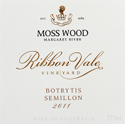 a variety of fruit and spice flavors coming to the forefront. Fruitcake spices emerge on the honeyed finish which has great length and nice acidity. This wine works equally well paired with other sweets or a cheese course.
a variety of fruit and spice flavors coming to the forefront. Fruitcake spices emerge on the honeyed finish which has great length and nice acidity. This wine works equally well paired with other sweets or a cheese course.
Tasting these wines in such a setting allowed us to see their aging potential as well as take a look at what the level of consistency is. While there was certainly vintage variation and some stylistic differences as they have made some adjustments in treatment over the years, each varietal had connective tissues within their subset that allowed us to see how they related to each other. The key here is that these wines were all made in a style that allowed their origin in the Margaret River to be showcased along with the vagaries of what each vintage brings. These are not manipulated products but vineyard driven wines that are allowed to shine. Each varietal is shepherded into bottle in a manner that makes long term aging not only possible but interesting and exciting. The Moss Wood wines taken as a whole were quite impressive. They’re fine examples of their place, their respective grapes and their particular vintages. If it’s been awhile since you’ve had top shelf Australian wine, the offerings from Moss Wood are a perfect spot to leap back in.
 The folks at Trione Vineyards & Winery farm property in three distinct appellations within Sonoma County, Russian River Valley, Alexander Valley & the Sonoma Coast. In total they have more than 650 acres. They use a small percentage of the resulting grapes to make the Trione Wines and sell the balance to others. Here’s a look at two of their current releases.
The Trione Vineyards & Winery 2010 Russian River Valley Chardonnay was produced using fruit sourced at their River Road Ranch vineyard. This is a 115 acre parcel in the middle of the Russian River Valley. The fruit was whole bunch pressed. Fermentation and aging occurred in French oak. 45% of the barrels utilized were new and the balance were composed of once and twice used oak. 862 cases of this Chardonnay were produced and it has a suggested retail price of $30. Baker’s spices and orchard fruit aromas dominate the lovely nose of this Chardonnay. Pineapple and yellow delicious apple flavors are prominently featured through the rich and layered palate which has loads of depth in the form of pure, unadulterated fruit flavors. Granny Smith apple, cloves, cinnamon, minerals a hint of crème fraiche are all part of the finish which is memorably lengthy. This wine is crisp, refreshing and lovely. It’s a fine, fine example of well made Russian River Valley Chardonnay at a fair price.
The folks at Trione Vineyards & Winery farm property in three distinct appellations within Sonoma County, Russian River Valley, Alexander Valley & the Sonoma Coast. In total they have more than 650 acres. They use a small percentage of the resulting grapes to make the Trione Wines and sell the balance to others. Here’s a look at two of their current releases.
The Trione Vineyards & Winery 2010 Russian River Valley Chardonnay was produced using fruit sourced at their River Road Ranch vineyard. This is a 115 acre parcel in the middle of the Russian River Valley. The fruit was whole bunch pressed. Fermentation and aging occurred in French oak. 45% of the barrels utilized were new and the balance were composed of once and twice used oak. 862 cases of this Chardonnay were produced and it has a suggested retail price of $30. Baker’s spices and orchard fruit aromas dominate the lovely nose of this Chardonnay. Pineapple and yellow delicious apple flavors are prominently featured through the rich and layered palate which has loads of depth in the form of pure, unadulterated fruit flavors. Granny Smith apple, cloves, cinnamon, minerals a hint of crème fraiche are all part of the finish which is memorably lengthy. This wine is crisp, refreshing and lovely. It’s a fine, fine example of well made Russian River Valley Chardonnay at a fair price.
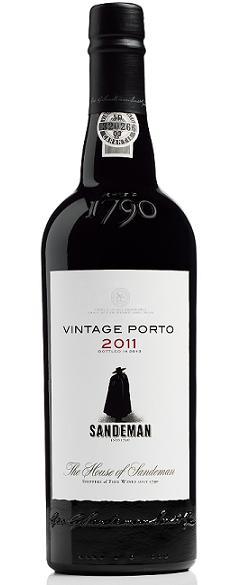 The Sandeman 2011 Vintage Porto was produced using a blend of Touriga Franca (40%), Touriga Nacional (40%), Tinta Roriz (10%), Tinta Cão (5%), and Sousão (5%). The fruit is of course all from the Douro. Grapes were partially de-stemmed and gently crushed. Maceration and fermentation followed in a temperature controlled environment. Addition of the aguardente (neutral spirit) followed. The following spring the wine was transported to Sandeman Cellars in Vila Nova de Gaia for maturation. After maturation and numerous tasting trials the final blend was achieved and the 2011 Vintage Porto was bottled in April of 2013. It was released in October of this year and is Sandeman’s first declared vintage Porto since the 2007. The 2011 Vintage Porto will sell for around $75 at most retailers. The color of this Port is deep, dark and dense. The nose is absolutely loaded with a stunning array of spice aromas which include fruitcake spices and a gentle wisp of anise. Tons of dark, complex layered fruits are on display throughout the gorgeous palate. Cherries and blackberries are of particular note. Dark, dusty baker’s chocolate and continued spices are part of a long, lusty and prodigious finish. This is a powerful and muscular port with firm tannins, fine acidity and excellent structure. It’s really just a baby now, but one with killer promise for future greatness. It has the hallmarks of what should become a classic, long lived vintage of Sandeman Porto. It’s a potent and fruit forward Port which is delicious now. This is particularly true if it’s paired with rich chocolate desserts or strong cheeses. However if you’re patient enough to lay a bottle or case of this wine down for a couple of decades (or more) you will be richly rewarded with a classic experience.
The Sandeman 2011 Vintage Porto was produced using a blend of Touriga Franca (40%), Touriga Nacional (40%), Tinta Roriz (10%), Tinta Cão (5%), and Sousão (5%). The fruit is of course all from the Douro. Grapes were partially de-stemmed and gently crushed. Maceration and fermentation followed in a temperature controlled environment. Addition of the aguardente (neutral spirit) followed. The following spring the wine was transported to Sandeman Cellars in Vila Nova de Gaia for maturation. After maturation and numerous tasting trials the final blend was achieved and the 2011 Vintage Porto was bottled in April of 2013. It was released in October of this year and is Sandeman’s first declared vintage Porto since the 2007. The 2011 Vintage Porto will sell for around $75 at most retailers. The color of this Port is deep, dark and dense. The nose is absolutely loaded with a stunning array of spice aromas which include fruitcake spices and a gentle wisp of anise. Tons of dark, complex layered fruits are on display throughout the gorgeous palate. Cherries and blackberries are of particular note. Dark, dusty baker’s chocolate and continued spices are part of a long, lusty and prodigious finish. This is a powerful and muscular port with firm tannins, fine acidity and excellent structure. It’s really just a baby now, but one with killer promise for future greatness. It has the hallmarks of what should become a classic, long lived vintage of Sandeman Porto. It’s a potent and fruit forward Port which is delicious now. This is particularly true if it’s paired with rich chocolate desserts or strong cheeses. However if you’re patient enough to lay a bottle or case of this wine down for a couple of decades (or more) you will be richly rewarded with a classic experience.
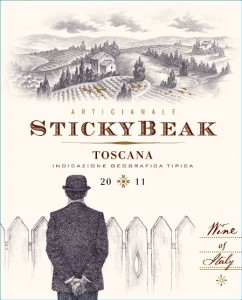 Stickybeak is a California based winery that sources grapes in a host of regions such as Napa, Sonoma and Monterey. They have now widened their reach by making a wine with fruit sourced in Italy. These particular grapes come from the 40 year old Cerreto Guidi vineyards located in Tuscany. Here’s a look at this Italian blend.
The Stickybeak 2011 Toscana was produced from a blend of Sangiovese (85%), Merlot (10%) and Syrah (5%). The Sangiovese and Merlot were both sourced in Tuscany with the Syrah coming from Maremma which is close by. Wild yeasts were used for fermentation which took place over roughly 15 days. Each varietal was aged separately over 18 months in entirely French oak. Blending occurred prior to bottling. This wine is finished in screw cap and has a suggested retail price of $20. Violet and red cherry aromas light up the nose of this Tuscan blend. Strawberry, cherry, spice, and vanilla bean are all in play throughout the palate which has nice depth. Leather, cherry, raspberry and black peppercorn flavors all show up in the finish which has above average length. This wine really shines when paired with food. Anything with red sauce on it will work well. I drank it with homemade pizza and it was memorable and delicious combo.
Stickybeak is a California based winery that sources grapes in a host of regions such as Napa, Sonoma and Monterey. They have now widened their reach by making a wine with fruit sourced in Italy. These particular grapes come from the 40 year old Cerreto Guidi vineyards located in Tuscany. Here’s a look at this Italian blend.
The Stickybeak 2011 Toscana was produced from a blend of Sangiovese (85%), Merlot (10%) and Syrah (5%). The Sangiovese and Merlot were both sourced in Tuscany with the Syrah coming from Maremma which is close by. Wild yeasts were used for fermentation which took place over roughly 15 days. Each varietal was aged separately over 18 months in entirely French oak. Blending occurred prior to bottling. This wine is finished in screw cap and has a suggested retail price of $20. Violet and red cherry aromas light up the nose of this Tuscan blend. Strawberry, cherry, spice, and vanilla bean are all in play throughout the palate which has nice depth. Leather, cherry, raspberry and black peppercorn flavors all show up in the finish which has above average length. This wine really shines when paired with food. Anything with red sauce on it will work well. I drank it with homemade pizza and it was memorable and delicious combo. Recently I had the opportunity to taste through the wines of
Recently I had the opportunity to taste through the wines of  Moss Wood 1991 Chardonnay – This 22 year old Chardonnay showcases a cavalcade of pure and expressive fruits. There is depth and complexity here to spare. Apple and pear flavors are joined by bits of hazelnut and toast. A bit of butter crème emerges on the finish which has excellent length and persistence. This is a gorgeous wine that exemplifies how fantastic Chardonnay can be when it’s treated appropriately all the way from vineyard to bottle.
Moss Wood 1991 Chardonnay – This 22 year old Chardonnay showcases a cavalcade of pure and expressive fruits. There is depth and complexity here to spare. Apple and pear flavors are joined by bits of hazelnut and toast. A bit of butter crème emerges on the finish which has excellent length and persistence. This is a gorgeous wine that exemplifies how fantastic Chardonnay can be when it’s treated appropriately all the way from vineyard to bottle.
 a variety of fruit and spice flavors coming to the forefront. Fruitcake spices emerge on the honeyed finish which has great length and nice acidity. This wine works equally well paired with other sweets or a cheese course.
a variety of fruit and spice flavors coming to the forefront. Fruitcake spices emerge on the honeyed finish which has great length and nice acidity. This wine works equally well paired with other sweets or a cheese course.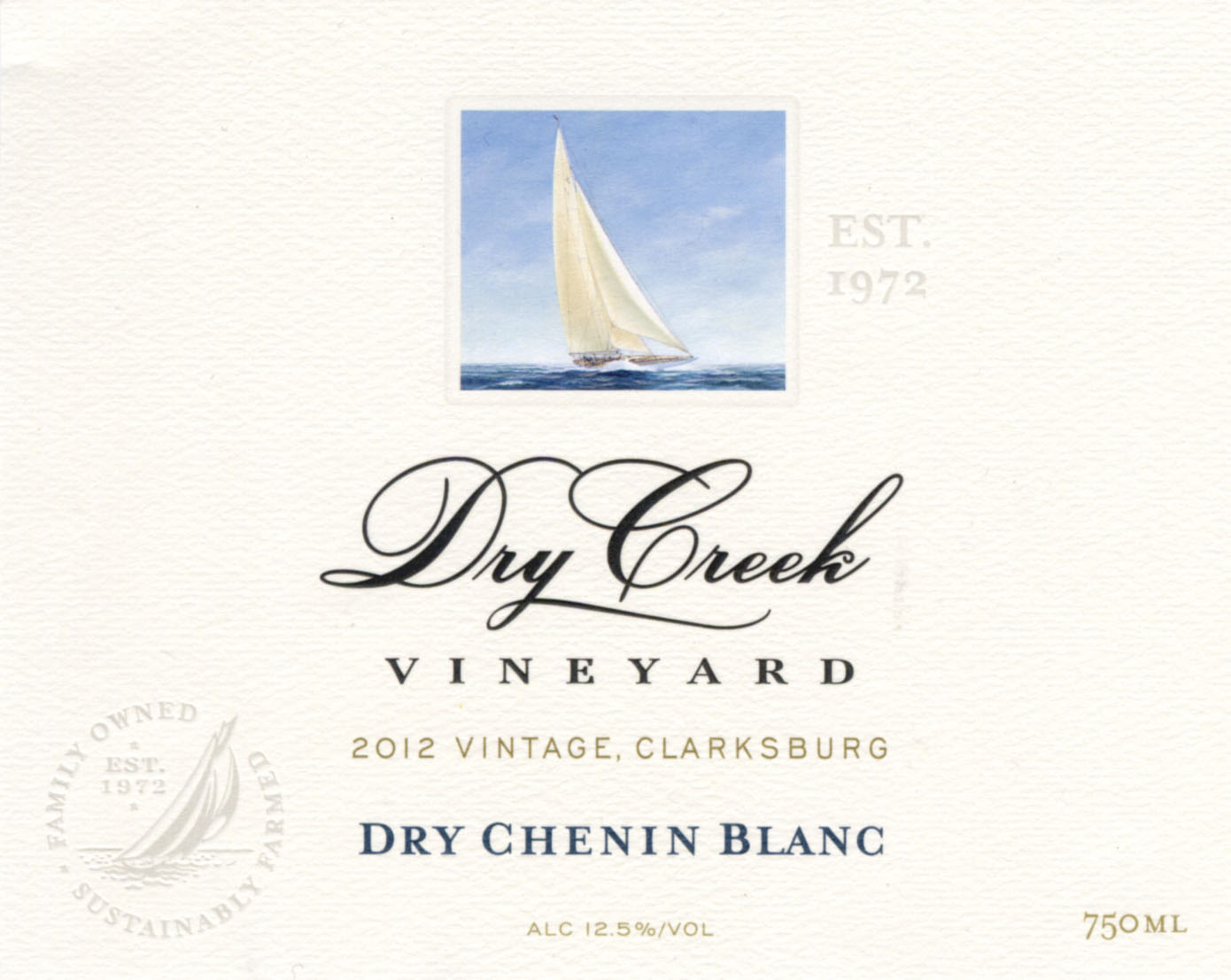 Dry Creek Vineyard is a family owned winery that is the namesake vineyard of their appellation as well as stunningly consistent producer of fine wines. Whether you’re looking for everyday values, appellation specific offerings or single vineyard wines, Dry Creek Vineyard has something to offer. They absolutely kill it when it comes to Sauvignon Blanc and Zinfandel, the two key grapes of Dry Creek Valley. But they do so much more. Here’s a look at the current vintage of one of their best value wines.
The Dry Creek Vineyard 2012 Dry Chenin Blanc was produced entirely from fruit sourced in the Clarksburg region of California. This offering is 100% Chenin Blanc. The vines these grapes came from had an average age of 10 years when this harvest occurred. Fermentation took place over 28 days in temperature controlled stainless steel. Just more than 13,000 cases of this wine were produced and it has a suggested retail price of $12. This wine has an ostentatious nose that simply leaps from the glass with white peach and Lychee fruit aromas dominating. Apricot and mango flavors are prominent on the palate along with a bit of spice. There is a fruity edge to the mellifluous finish which gives the impression of sweetness as is persists and lingers on the back of the throat.
Dry Creek Vineyard is a family owned winery that is the namesake vineyard of their appellation as well as stunningly consistent producer of fine wines. Whether you’re looking for everyday values, appellation specific offerings or single vineyard wines, Dry Creek Vineyard has something to offer. They absolutely kill it when it comes to Sauvignon Blanc and Zinfandel, the two key grapes of Dry Creek Valley. But they do so much more. Here’s a look at the current vintage of one of their best value wines.
The Dry Creek Vineyard 2012 Dry Chenin Blanc was produced entirely from fruit sourced in the Clarksburg region of California. This offering is 100% Chenin Blanc. The vines these grapes came from had an average age of 10 years when this harvest occurred. Fermentation took place over 28 days in temperature controlled stainless steel. Just more than 13,000 cases of this wine were produced and it has a suggested retail price of $12. This wine has an ostentatious nose that simply leaps from the glass with white peach and Lychee fruit aromas dominating. Apricot and mango flavors are prominent on the palate along with a bit of spice. There is a fruity edge to the mellifluous finish which gives the impression of sweetness as is persists and lingers on the back of the throat. In general people love Red Blends. Well when they’re tasty of course. There are all sorts of styles out there but the ones I’m specifically talking about today are the kind that are well priced, made for a wide audience and generally available. These have a found a big following with different kinds of wine lovers. To the novice Red wine drinker they can be easy to drink and appealing. To the seasoned wine drinker they offer something tasty and easy on the budget that will satisfy a lot of different taste buds. Murphy-Goode has a new blend called Homefront Red. For every bottle of this wine sold Murphy-Goode will doncate 50 cents to Operation Homefront, a national nonprofit that provides emergency and financial assiustance to the families of service members and wounded warriors. With that in mind here’s a look at the wine.
The Murphy-Goode 2011 Homefront Red was produced from fruit sourced throughout California. This offering blends together Syrah, Merlot, Petite Sirah and Zinfandel. This wine was aged in a combination of French and American oak. It was recently released and is available nationally. 50,000 Cases were produced and it has a suggested retail price of $15. Blackberry and raspberry aromas light up the nose of this wine along with a little hint of anise. The palate is loaded with berry fruit flavors such as black raspberry and spices galore. Red Cherry is present as well and leads to the finish which has wisps of sweet chocolate and black pepper. Homefront Red will pair well with a pretty wide array of foods. It will be particularly good with casual grilled foods.
In general people love Red Blends. Well when they’re tasty of course. There are all sorts of styles out there but the ones I’m specifically talking about today are the kind that are well priced, made for a wide audience and generally available. These have a found a big following with different kinds of wine lovers. To the novice Red wine drinker they can be easy to drink and appealing. To the seasoned wine drinker they offer something tasty and easy on the budget that will satisfy a lot of different taste buds. Murphy-Goode has a new blend called Homefront Red. For every bottle of this wine sold Murphy-Goode will doncate 50 cents to Operation Homefront, a national nonprofit that provides emergency and financial assiustance to the families of service members and wounded warriors. With that in mind here’s a look at the wine.
The Murphy-Goode 2011 Homefront Red was produced from fruit sourced throughout California. This offering blends together Syrah, Merlot, Petite Sirah and Zinfandel. This wine was aged in a combination of French and American oak. It was recently released and is available nationally. 50,000 Cases were produced and it has a suggested retail price of $15. Blackberry and raspberry aromas light up the nose of this wine along with a little hint of anise. The palate is loaded with berry fruit flavors such as black raspberry and spices galore. Red Cherry is present as well and leads to the finish which has wisps of sweet chocolate and black pepper. Homefront Red will pair well with a pretty wide array of foods. It will be particularly good with casual grilled foods.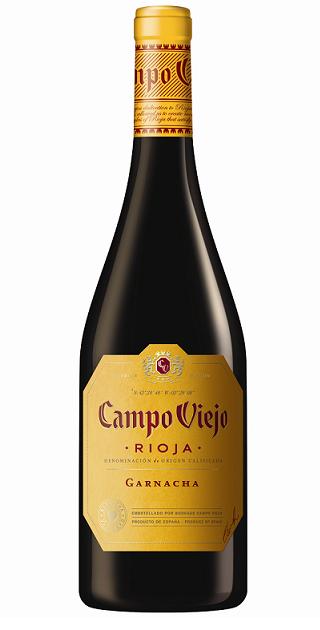 The Rioja region of Spain is bet known for wines based on Tempranillo. Often these are single varietal wines, other times they have small amounts of indigenous local varieties blended in as well. Campo Viejo is a winery that falls right into that description. They make a number of Tempranillo based wines in different tiers within the Spanish wine aging laws. Now they have added the first ever Garnacha to their portfolio. Here’s a look at it.
The Campo Viejo 2012 Garnacha is an inaugural release for this well known, widely distributed winery based in the Rioja region of Spain. This release is made entirely of Garnacha sourced at their vineyards in the Alfaro and Aldeanueva sections of Rioja Baja. Fermentation took place in temperature controlled stainless steel vats. Aging in French oak barrels took place over 4 months. This wine is available all over the country and has a suggested retail price of $12.00. Violets and dark, heady fruit aromas emerge from the nose of this 2012 Garnacha. A gentle wisp of vanilla bean is present as well. The palate is studded with plum, blueberry and raspberry flavors. Spices such as pepper and clove are present as well and lead to the finish which shows off rhubarb and strawberry as well as tiny bits of anise seed. The finish has solid length for the price range.
The Rioja region of Spain is bet known for wines based on Tempranillo. Often these are single varietal wines, other times they have small amounts of indigenous local varieties blended in as well. Campo Viejo is a winery that falls right into that description. They make a number of Tempranillo based wines in different tiers within the Spanish wine aging laws. Now they have added the first ever Garnacha to their portfolio. Here’s a look at it.
The Campo Viejo 2012 Garnacha is an inaugural release for this well known, widely distributed winery based in the Rioja region of Spain. This release is made entirely of Garnacha sourced at their vineyards in the Alfaro and Aldeanueva sections of Rioja Baja. Fermentation took place in temperature controlled stainless steel vats. Aging in French oak barrels took place over 4 months. This wine is available all over the country and has a suggested retail price of $12.00. Violets and dark, heady fruit aromas emerge from the nose of this 2012 Garnacha. A gentle wisp of vanilla bean is present as well. The palate is studded with plum, blueberry and raspberry flavors. Spices such as pepper and clove are present as well and lead to the finish which shows off rhubarb and strawberry as well as tiny bits of anise seed. The finish has solid length for the price range. European wine can be intimidating to wine drinkers for a variety of reasons. Those with an interest in wine but who aren't total geeks about it don’t necessarily know the nuances of labeling and what might be in a particular bottle due to it generally listing region as opposed to varietal content. Stylistically many old world wines are often subtler than their new world counterparts and it can take time for palates to come around to the layered charms of those often elegant offerings. In contrast to all of that Domaines Paul Mas from the Languedoc region of France has some releases that are labeled in such a way that even the budding wine lover can easily discern contents. Additionally they are making wines that bridge the gap in style between the old and new worlds. Here’s a look at three of their current releases.
The Paul Mas 2011 Estate Pinot Noir is a single vineyard effort. All of the fruit for this wine came from their St. Hilaire Vineyard located in the Languedoc Region. This offering is 100% Pinot Noir. After maceration the fruit was fermented in a temperature controlled environment for approximately 9 days. Aging took place over 6 months in stainless steel, followed by 2 months in bottle prior to release. This wine has a suggested retail price of $14. Aromas of Strawberry and red cherry fill the nose of this Pinot Noir along with secondary characteristics such as mushroom. Those red fruit characteristics carry through the palate which is towards the more substantial side for Pinot Noir. Minerals, spice and earth are all in strong evidence on the finish which has good length. Medium tannins and zippy acidity lend to a nice backbone and structure here. This is a Pinot from the old world that shows off new world flavors while still being proportionate.
European wine can be intimidating to wine drinkers for a variety of reasons. Those with an interest in wine but who aren't total geeks about it don’t necessarily know the nuances of labeling and what might be in a particular bottle due to it generally listing region as opposed to varietal content. Stylistically many old world wines are often subtler than their new world counterparts and it can take time for palates to come around to the layered charms of those often elegant offerings. In contrast to all of that Domaines Paul Mas from the Languedoc region of France has some releases that are labeled in such a way that even the budding wine lover can easily discern contents. Additionally they are making wines that bridge the gap in style between the old and new worlds. Here’s a look at three of their current releases.
The Paul Mas 2011 Estate Pinot Noir is a single vineyard effort. All of the fruit for this wine came from their St. Hilaire Vineyard located in the Languedoc Region. This offering is 100% Pinot Noir. After maceration the fruit was fermented in a temperature controlled environment for approximately 9 days. Aging took place over 6 months in stainless steel, followed by 2 months in bottle prior to release. This wine has a suggested retail price of $14. Aromas of Strawberry and red cherry fill the nose of this Pinot Noir along with secondary characteristics such as mushroom. Those red fruit characteristics carry through the palate which is towards the more substantial side for Pinot Noir. Minerals, spice and earth are all in strong evidence on the finish which has good length. Medium tannins and zippy acidity lend to a nice backbone and structure here. This is a Pinot from the old world that shows off new world flavors while still being proportionate. Holiday weekends, parties and festive gatherings of every shape and size always get my mind thinking about what kind of wine to serve. These events offer a particular challenge. What will make the casual drinker happy and still keep the wine lovers interested? And certainly it wouldn't hurt if it’s a wine that pairs well with a broad array of foods. Of course one answer would be to serve multiple wines but that has various complicating factors. So when possible I strive to find one main wine to serve at large gatherings. Here’s a look at what I plan to pour this upcoming Labor Day.
The Frisk 2012 Prickly Rosso was produced from fruit sourced in the Victoria region of Australia. This offering blends together Merlot (51%) and Docletto (49%). Fermentation took place in stainless steel with a selection of yeasts. This wine features a bit of fizz brought on by the yeast. It has a suggested retail price of $11.
Holiday weekends, parties and festive gatherings of every shape and size always get my mind thinking about what kind of wine to serve. These events offer a particular challenge. What will make the casual drinker happy and still keep the wine lovers interested? And certainly it wouldn't hurt if it’s a wine that pairs well with a broad array of foods. Of course one answer would be to serve multiple wines but that has various complicating factors. So when possible I strive to find one main wine to serve at large gatherings. Here’s a look at what I plan to pour this upcoming Labor Day.
The Frisk 2012 Prickly Rosso was produced from fruit sourced in the Victoria region of Australia. This offering blends together Merlot (51%) and Docletto (49%). Fermentation took place in stainless steel with a selection of yeasts. This wine features a bit of fizz brought on by the yeast. It has a suggested retail price of $11. Certain things in the wine world hit my sweet spot. That could certainly be particular grapes or styles of wine. But one thing that hits my sweet spot almost every time is a solid value. I’m a firm believer that at any price point a wine can be a value for the quality and style it represents in its category. However in this case I’m talking about everyday values. This is a huge category of wine; numerous categories lumped together at times actually, aimed at people’s everyday drinking budget. Wine lovers are always on the hunt for something that tastes good, offers some depth and doesn’t cost a ton. Trouble is that the vast category of everyday value contains lots of unpleasant or at the very least anonymous wines. We’ve all had them, you take a sip, then another and all you can do is confirm, “yup that’s wine.” What that represents to me is sadness, because there are lots of delicious wines available that are well made and offer excellent value. Here’s a look at a terrific one in the most difficult category of all in my opinion, value priced Pinot Noir.
The Brancott Estate 2011 Marlborough Pinot Noir was produced from fruit sourced in the namesake region. This wine is entirely Pinot Noir. The vines used represent a handful of different Pinot Noir clones allowing for a broader flavor profile. After harvesting the fruit was destemmed and cold soaked for four days prior to fermentation utilizing an array of yeast strains. This Pinot was aged over four months in a combination of stainless steel and oak. This wine is widely available around the country and has a suggested retail price of $12.99. However it often sells for closer to $10, so shop around.
Certain things in the wine world hit my sweet spot. That could certainly be particular grapes or styles of wine. But one thing that hits my sweet spot almost every time is a solid value. I’m a firm believer that at any price point a wine can be a value for the quality and style it represents in its category. However in this case I’m talking about everyday values. This is a huge category of wine; numerous categories lumped together at times actually, aimed at people’s everyday drinking budget. Wine lovers are always on the hunt for something that tastes good, offers some depth and doesn’t cost a ton. Trouble is that the vast category of everyday value contains lots of unpleasant or at the very least anonymous wines. We’ve all had them, you take a sip, then another and all you can do is confirm, “yup that’s wine.” What that represents to me is sadness, because there are lots of delicious wines available that are well made and offer excellent value. Here’s a look at a terrific one in the most difficult category of all in my opinion, value priced Pinot Noir.
The Brancott Estate 2011 Marlborough Pinot Noir was produced from fruit sourced in the namesake region. This wine is entirely Pinot Noir. The vines used represent a handful of different Pinot Noir clones allowing for a broader flavor profile. After harvesting the fruit was destemmed and cold soaked for four days prior to fermentation utilizing an array of yeast strains. This Pinot was aged over four months in a combination of stainless steel and oak. This wine is widely available around the country and has a suggested retail price of $12.99. However it often sells for closer to $10, so shop around. Trione Vineyards & Winery is located on 115 acres in the midst of Russian River Valley one of Sonoma County’s great and storied appellations. From that property they make a handful of small lot wines. Several of them are available nationally. Here’s a look at their new release Sauvignon Blanc.
The Trione 2012 Russian River Valley Sauvignon Blanc was produced using fruit sourced exclusively at their River Road Ranch site. The Sauvignon Blanc vines had 12 years of age on them at the time of harvest. The fruit was hand picked and pressed into stainless steel. A wild yeast strain from South Africa was utilized for fermentation. This offering is 100% varietal. After fermentation aging took place over 4 months in a combination of new (10%) and neutral (90%) oak barrels. Just fewer than 1,500 cases of this Sauvignon Blanc were produced and it has a suggested retail price of $23.
Trione Vineyards & Winery is located on 115 acres in the midst of Russian River Valley one of Sonoma County’s great and storied appellations. From that property they make a handful of small lot wines. Several of them are available nationally. Here’s a look at their new release Sauvignon Blanc.
The Trione 2012 Russian River Valley Sauvignon Blanc was produced using fruit sourced exclusively at their River Road Ranch site. The Sauvignon Blanc vines had 12 years of age on them at the time of harvest. The fruit was hand picked and pressed into stainless steel. A wild yeast strain from South Africa was utilized for fermentation. This offering is 100% varietal. After fermentation aging took place over 4 months in a combination of new (10%) and neutral (90%) oak barrels. Just fewer than 1,500 cases of this Sauvignon Blanc were produced and it has a suggested retail price of $23. With summer weather in full swing for weeks now, I’ve been going through more Rosé than ever. That’s partly because my thirst for them increases year after year; in addition to that we see more and more Rosé’s on our shelves from all corners of the globe as time marches on. Here’s a look at two I just tried and really enjoyed.
The Luigi Bosca Finca La Linda 2012 Rosé was produced from fruit sourced in the Mendoza region of Argentina. This offering is 100% Malbec. Fruit for this Rosé was hand picked, sorted and destemmed. Fermentation took place in a temperature controlled stainless steel tanks at cool temperatures. This widely available wine has a suggested retail price of $13. This Rosé has a darker, more vibrant hue than the average. Aromas of wild strawberry jam leap from the nose of this wine. Bright raspberry, cherry and bits of orange characteristics light up the palate with a ton of scrumptious flavors. Vanilla bean, sweet cherry and white pepper notes are all in evidence on the finish which has good length and shows off firm, crispy acidity. This wine will go well with a variety of foods; I found it to be particularly excellent with spicy chicken tacos.
With summer weather in full swing for weeks now, I’ve been going through more Rosé than ever. That’s partly because my thirst for them increases year after year; in addition to that we see more and more Rosé’s on our shelves from all corners of the globe as time marches on. Here’s a look at two I just tried and really enjoyed.
The Luigi Bosca Finca La Linda 2012 Rosé was produced from fruit sourced in the Mendoza region of Argentina. This offering is 100% Malbec. Fruit for this Rosé was hand picked, sorted and destemmed. Fermentation took place in a temperature controlled stainless steel tanks at cool temperatures. This widely available wine has a suggested retail price of $13. This Rosé has a darker, more vibrant hue than the average. Aromas of wild strawberry jam leap from the nose of this wine. Bright raspberry, cherry and bits of orange characteristics light up the palate with a ton of scrumptious flavors. Vanilla bean, sweet cherry and white pepper notes are all in evidence on the finish which has good length and shows off firm, crispy acidity. This wine will go well with a variety of foods; I found it to be particularly excellent with spicy chicken tacos.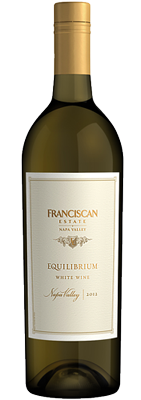 I've been enjoying wines from Franciscan Estate since my earliest familiarity with Napa Valley. In that time they've featured a consistently appealing portfolio of wines. Franciscan has also been steady in terms of what they release; their core has remained reliable as well. However every now and then they add something new. This summer it’s a new white blend, focused mostly on two varietals they have worked with for years. Here’s a look at it.
The Franciscan Estate 2012 Equilibrium is the inaugural release of this wine. This white blend combines Sauvignon Blanc (72%), Chardonnay (17%), and Muscat (11%). All of the fruit for this wine was sourced in Napa Valley. 83% of the fruit was fermented in stainless steel and the remaining 17% in barrel. Just fewer than 6,000 cases of Equilibrium were produced and it has a suggested retail price of $22.99. This wine leads with a killer nose; tropical and stone fruit aromas simply burst out of the glass invitingly. Equilibrium’s palate is studded with an array of engaging bright fruit flavors; white peach, guava and mango are of particular note here. Lemon curd, white pepper and continued tropical fruit flavors abound on the finish which has nice length. This wine is soft, round, lush and mouth-filling.
I've been enjoying wines from Franciscan Estate since my earliest familiarity with Napa Valley. In that time they've featured a consistently appealing portfolio of wines. Franciscan has also been steady in terms of what they release; their core has remained reliable as well. However every now and then they add something new. This summer it’s a new white blend, focused mostly on two varietals they have worked with for years. Here’s a look at it.
The Franciscan Estate 2012 Equilibrium is the inaugural release of this wine. This white blend combines Sauvignon Blanc (72%), Chardonnay (17%), and Muscat (11%). All of the fruit for this wine was sourced in Napa Valley. 83% of the fruit was fermented in stainless steel and the remaining 17% in barrel. Just fewer than 6,000 cases of Equilibrium were produced and it has a suggested retail price of $22.99. This wine leads with a killer nose; tropical and stone fruit aromas simply burst out of the glass invitingly. Equilibrium’s palate is studded with an array of engaging bright fruit flavors; white peach, guava and mango are of particular note here. Lemon curd, white pepper and continued tropical fruit flavors abound on the finish which has nice length. This wine is soft, round, lush and mouth-filling. Hecht & Bannier was founded in 2002 by Gregory Hecht and Francois Bannier. They set themselves up in the style of traditional French Negociants with a goal of creating reference point releases in each region they produce wines from. The latest additions to their portfolio are a couple of wines from Provence. Here’s a look at them.
The Hecht & Bannier Côtes de Provence 2012 Rosé was produced from a blend of Grenache (45%), Cinsault (40%) and Syrah (15%). The grapes utilized were sourced at a variety of vineyards, some in the foothills of Montagne Sainte-Victorie and others high altitude vineyards of Haute-Provence. The fruit was picked overnight during cooler hours to assure the preservation of freshness. This wine has a suggested retail price of $18. The light salmon hue of this offering is both beautiful and immediately striking. Engaging floral characteristics emerge from the nose. The palate is fruity, spice, dry, lithe and absolutely lovely. Cherry, strawberry, bits of orange zest and white pepper are all in play from the first sip through the above average finish. This wine goes down easily and it also has the depth and complexity to keep things interesting. It’s really a super appealing wine that you’re going to want to buy a few bottles of as they disappear quick once they’re open.
Hecht & Bannier was founded in 2002 by Gregory Hecht and Francois Bannier. They set themselves up in the style of traditional French Negociants with a goal of creating reference point releases in each region they produce wines from. The latest additions to their portfolio are a couple of wines from Provence. Here’s a look at them.
The Hecht & Bannier Côtes de Provence 2012 Rosé was produced from a blend of Grenache (45%), Cinsault (40%) and Syrah (15%). The grapes utilized were sourced at a variety of vineyards, some in the foothills of Montagne Sainte-Victorie and others high altitude vineyards of Haute-Provence. The fruit was picked overnight during cooler hours to assure the preservation of freshness. This wine has a suggested retail price of $18. The light salmon hue of this offering is both beautiful and immediately striking. Engaging floral characteristics emerge from the nose. The palate is fruity, spice, dry, lithe and absolutely lovely. Cherry, strawberry, bits of orange zest and white pepper are all in play from the first sip through the above average finish. This wine goes down easily and it also has the depth and complexity to keep things interesting. It’s really a super appealing wine that you’re going to want to buy a few bottles of as they disappear quick once they’re open.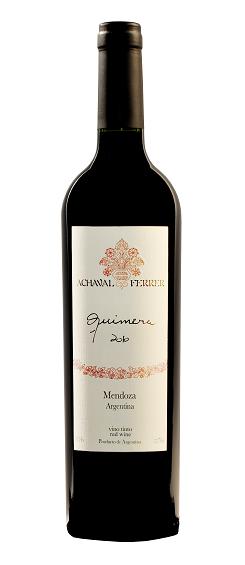 Many wine making regions produce Bordeaux inspired blends and the results vary greatly. In my mind the downfall often comes when trying to mimic the great wines of Bordeaux to the point of not focusing on what does best in the region in question. Argentina of course is best known for Malbec which thrives there in a variety of styles. The latest release from Bodega Achaval-Ferrer is a Bordeaux inspired blend and it’s also a wine with a relatively large percentage of Malbec in it. So here’s a release where Bordeaux inspiration and local rock-star grape meet. Here are my thoughts on the results.
The Achaval-Ferrer 2010 Quimera was produced from fruit sourced in three appellations: Lujan de Cuyo, Medrano, and Tupungato. This offering is a blend of Malbec (31%), Merlot (20%), Cabernet Sauvignon (27%), Cabernet Franc (18%) and Petit Verdot (4%). Each varietal underwent primary fermentation separately in small tanks; Malolactic fermentation followed after the wine was blended. Barrel aging took place over 12 months in entirely French oak; 40% of the barrels utilized were new and the balance had been used once prior. Just more than 3,000 cases of this wine were produced and it has a suggested retail price of $56.
Many wine making regions produce Bordeaux inspired blends and the results vary greatly. In my mind the downfall often comes when trying to mimic the great wines of Bordeaux to the point of not focusing on what does best in the region in question. Argentina of course is best known for Malbec which thrives there in a variety of styles. The latest release from Bodega Achaval-Ferrer is a Bordeaux inspired blend and it’s also a wine with a relatively large percentage of Malbec in it. So here’s a release where Bordeaux inspiration and local rock-star grape meet. Here are my thoughts on the results.
The Achaval-Ferrer 2010 Quimera was produced from fruit sourced in three appellations: Lujan de Cuyo, Medrano, and Tupungato. This offering is a blend of Malbec (31%), Merlot (20%), Cabernet Sauvignon (27%), Cabernet Franc (18%) and Petit Verdot (4%). Each varietal underwent primary fermentation separately in small tanks; Malolactic fermentation followed after the wine was blended. Barrel aging took place over 12 months in entirely French oak; 40% of the barrels utilized were new and the balance had been used once prior. Just more than 3,000 cases of this wine were produced and it has a suggested retail price of $56. Chile is a country whose wines have been of interest to me for a long time. It’s an interest that has grown over time as the wines have increased in quality and diversity. Exciting things are happening in Chile and some of them are with long standing producers and others with newer ones.
Chile is a country whose wines have been of interest to me for a long time. It’s an interest that has grown over time as the wines have increased in quality and diversity. Exciting things are happening in Chile and some of them are with long standing producers and others with newer ones. 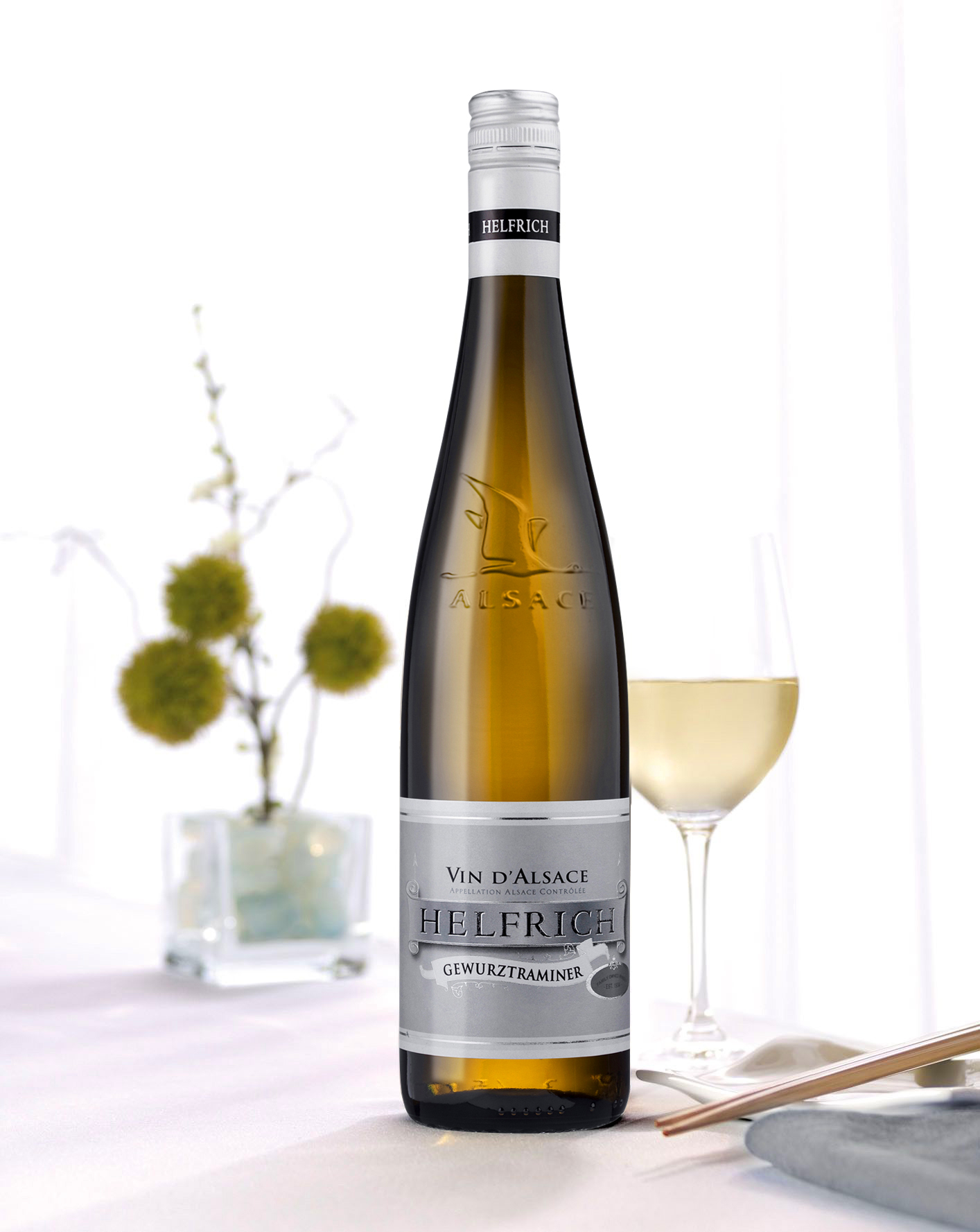 I recently had the opportunity to enjoy dinner with Helfrich Winemaker Nicolas Haeffelin and taste current releases of his wines. Helfrich is a family owned winery that was founded in 1934; it sits in the northern part of Alsace. They farm the Steinklotz vineyard which is one of only 51 in all of Alsace that has Grand Cru status. Additionally they source some of their fruit under long term arrangements with trusted neighbors. Amazingly Nicolas’ family has had a winemaker in every generation dating back to 1560. Prior to his time back home in Alsace Nicolas studied and worked in Burgundy and then spent a six months in New Zealand. It was a pleasure tasting wine with Nicolas and witnessing his passion for his work. Helfrich’s portfolio includes a carefully considered array of wines that share commonalities of quality while they are also each distinct. What follows are my thoughts on a trio of my personal favorites from the evening.
The Helfrich 2012 Gewurztraminer was produced entirely from fruit sourced in Alsace. This wine is composed entirely of Gewurztraminer. After harvesting the fruit was destemmed and placed in a horizontal press. The juice was then passed into stainless steel tanks for fermentation. It was settled and racked on the lees to help round it out. This wine is finished in screw cap and has a suggested retail price of $14.99. This wine opens with a gloriously big nose that shows off tropical fruit aromas in abundance. The palate has apricot and Lychee fruit was well as white cling peach flavors. The finish is long and lusty with bits of mesquite honey and spice closing things out. The Helfrich Gewurztraminer is a gorgeous wine that I simply wanted to keep drinking.
I recently had the opportunity to enjoy dinner with Helfrich Winemaker Nicolas Haeffelin and taste current releases of his wines. Helfrich is a family owned winery that was founded in 1934; it sits in the northern part of Alsace. They farm the Steinklotz vineyard which is one of only 51 in all of Alsace that has Grand Cru status. Additionally they source some of their fruit under long term arrangements with trusted neighbors. Amazingly Nicolas’ family has had a winemaker in every generation dating back to 1560. Prior to his time back home in Alsace Nicolas studied and worked in Burgundy and then spent a six months in New Zealand. It was a pleasure tasting wine with Nicolas and witnessing his passion for his work. Helfrich’s portfolio includes a carefully considered array of wines that share commonalities of quality while they are also each distinct. What follows are my thoughts on a trio of my personal favorites from the evening.
The Helfrich 2012 Gewurztraminer was produced entirely from fruit sourced in Alsace. This wine is composed entirely of Gewurztraminer. After harvesting the fruit was destemmed and placed in a horizontal press. The juice was then passed into stainless steel tanks for fermentation. It was settled and racked on the lees to help round it out. This wine is finished in screw cap and has a suggested retail price of $14.99. This wine opens with a gloriously big nose that shows off tropical fruit aromas in abundance. The palate has apricot and Lychee fruit was well as white cling peach flavors. The finish is long and lusty with bits of mesquite honey and spice closing things out. The Helfrich Gewurztraminer is a gorgeous wine that I simply wanted to keep drinking.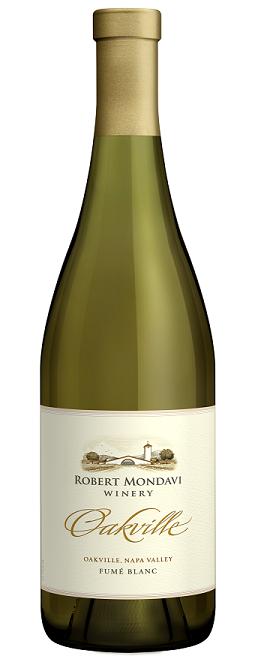 Few things in life are totally indisputable. One of them is that there is no single person more important to the history of the California wine industry than Robert Mondavi. It was Bob who championed Napa Valley more vociferously than anyone before or perhaps since. He believed before anyone else that wines equal to any in the world could be produced in Napa. Without his irrepressible passion for the wines of Napa and the forward movement of the Valley as an important wine making region it’s impossible to say how long it would have taken for it to achieve the heights it has. Mr. Mondavi would have been 100 years old today. On this occasion it’s important to reflect on what he still means to the wine world. Innovation, advancement and quality were things he held dear. I’ll take a look at two wines today, both from the To Kalon vineyard in Oakville. Appropriately one of them is an inaugural release of a new wine from that vineyard. What better way to honor a man who kept moving forward than with a new offering from a world renowned vineyard in Oakville that he championed.
First up is the Robert Mondavi Winery 2011 Oakville District Fumé Blanc. The fruit for this wine was sourced at the To Kalon vineyard in Oakville adjacent to the winery itself. In addition to Sauvignon Blanc (91%), a small amount of Sémillon (9%) was blended in. The fruit was hand picked and whole cluster pressed. 90% of the wine was barrel fermented in 60 gallon French oak; the balance in stainless steel tanks. The entire lot was aged in barrel with 12% new oak utilized. This wine has a suggested retail price of $32. Aromas of fresh cut grass and lemon zest inform the welcoming nose of this 2011 Sauvignon Blanc based wine. The palate here is dense and layerd; loaded with honeydew melon as well as copious quantities of citrus and tropical fruit characteristics. Essence of orange shows up on the prodigiously persistent finish along with white pepper. What impresses most about this offering is a deep level of refinement and complexity. There is depth, fruit, spices and all sorts of flavors to spare, but all in proportion. This is a gorgeous example of Sauvignon Blanc that is well worth its asking price.
Few things in life are totally indisputable. One of them is that there is no single person more important to the history of the California wine industry than Robert Mondavi. It was Bob who championed Napa Valley more vociferously than anyone before or perhaps since. He believed before anyone else that wines equal to any in the world could be produced in Napa. Without his irrepressible passion for the wines of Napa and the forward movement of the Valley as an important wine making region it’s impossible to say how long it would have taken for it to achieve the heights it has. Mr. Mondavi would have been 100 years old today. On this occasion it’s important to reflect on what he still means to the wine world. Innovation, advancement and quality were things he held dear. I’ll take a look at two wines today, both from the To Kalon vineyard in Oakville. Appropriately one of them is an inaugural release of a new wine from that vineyard. What better way to honor a man who kept moving forward than with a new offering from a world renowned vineyard in Oakville that he championed.
First up is the Robert Mondavi Winery 2011 Oakville District Fumé Blanc. The fruit for this wine was sourced at the To Kalon vineyard in Oakville adjacent to the winery itself. In addition to Sauvignon Blanc (91%), a small amount of Sémillon (9%) was blended in. The fruit was hand picked and whole cluster pressed. 90% of the wine was barrel fermented in 60 gallon French oak; the balance in stainless steel tanks. The entire lot was aged in barrel with 12% new oak utilized. This wine has a suggested retail price of $32. Aromas of fresh cut grass and lemon zest inform the welcoming nose of this 2011 Sauvignon Blanc based wine. The palate here is dense and layerd; loaded with honeydew melon as well as copious quantities of citrus and tropical fruit characteristics. Essence of orange shows up on the prodigiously persistent finish along with white pepper. What impresses most about this offering is a deep level of refinement and complexity. There is depth, fruit, spices and all sorts of flavors to spare, but all in proportion. This is a gorgeous example of Sauvignon Blanc that is well worth its asking price.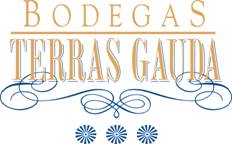 The Rías Baixas region sits in the north of Spain. The predominate grape in this region is Albariño. Within this one relatively small region there are 5 distinct sub-zones. Today I’ll look at a wine from the O Rosal zone which borders the north of Portugal.
The Bodegas Terras Gauda 2012 Terras Gauda O Rosal was produced from estate grown fruit. The estate sits on the banks of the Miño River within the Rias Baixas appellation in Galacia Spain. This offering is a blend of three indigenous varietals; Albariño (70%), Loureiro (18%), and Caiño Blanco (12%). Fermentation took place in temperature controlled stainless steel tanks, utilizing native yeasts. Approximately 1 million cases of this offering were produced and it has a suggested retail price of $24.
The Rías Baixas region sits in the north of Spain. The predominate grape in this region is Albariño. Within this one relatively small region there are 5 distinct sub-zones. Today I’ll look at a wine from the O Rosal zone which borders the north of Portugal.
The Bodegas Terras Gauda 2012 Terras Gauda O Rosal was produced from estate grown fruit. The estate sits on the banks of the Miño River within the Rias Baixas appellation in Galacia Spain. This offering is a blend of three indigenous varietals; Albariño (70%), Loureiro (18%), and Caiño Blanco (12%). Fermentation took place in temperature controlled stainless steel tanks, utilizing native yeasts. Approximately 1 million cases of this offering were produced and it has a suggested retail price of $24.